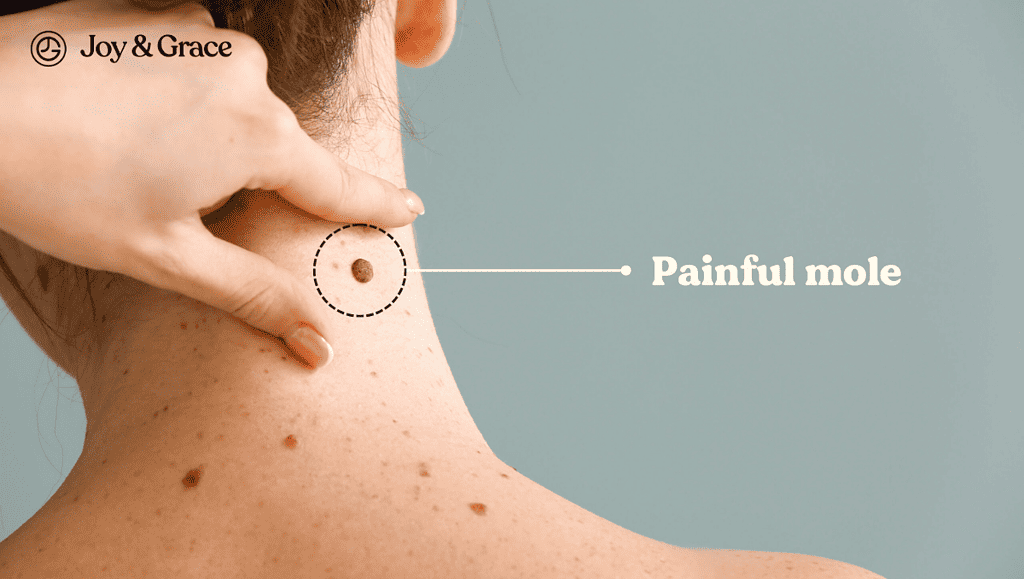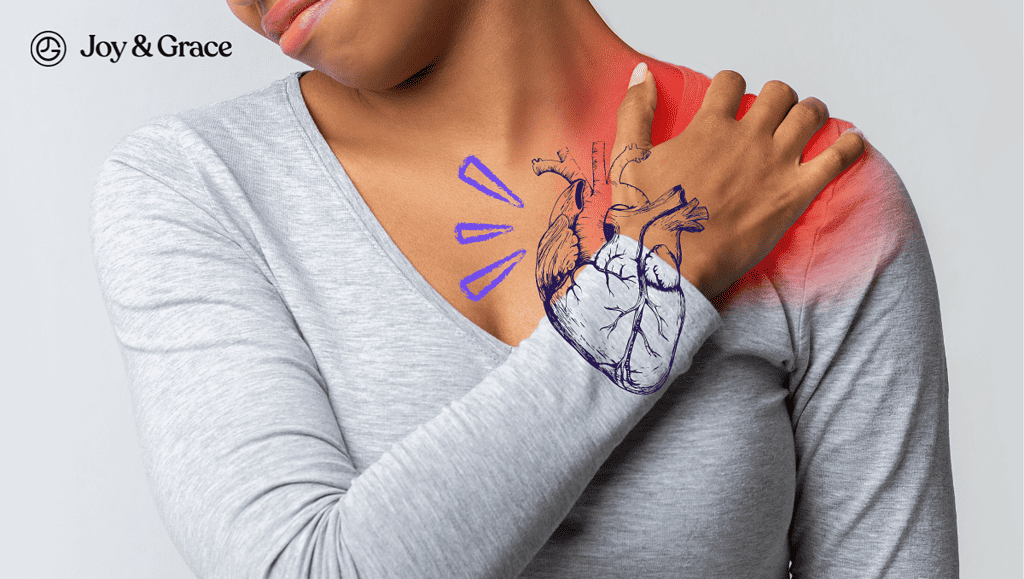Moles that are big, growing, or don't look right could mean that the skin is at risk of getting melanoma, which can be dangerous.
Melanoma is a type of skin cancer that happens when melanocytes, the cells that give the skin its tan or brown color, start to grow out of control.
Read on to learn more about the painful mole on the neck and whether it could be a sign of something more serious, like melanoma.
Why Is My Mole Painful?
Most moles don't hurt, but sometimes you might feel some pain. Several things can cause this to happen:
- An injury to the mole. If you scratch a mole by accident, it can hurt and get red.
- An infected mole. A mole can get infected if you scratch it or if something like bacteria gets into it. This can cause redness, itching, swelling, and pain.
- The presence of a foreign body. For instance, a pimple may form right under the mole and get stuck for a while. The pimple may take longer than usual to go away because it can't get to the surface of the skin easily.
Why Is My Mole Swollen And Sore?
Moles that are infected can be red and swollen. Other things that can make a mole sore are getting caught on clothing, getting sunburned, or having hair grow out of the mole.
Also, moles can get sore and swollen when they are rubbed or hurt, which makes them irritated. Most of the time, agitating the mole, like by shaving, can make it red and swollen.
Skin cancer, on the other hand, can also be caused by these changes. The important thing is to be able to tell the difference between irritation and cancer.
A mole that is getting bigger could be a sign of melanoma, not just irritation. When looking over the body to check the skin, it's important to pay attention to even the smallest changes.
What Does A Cancerous Mole Feel Like?
Here’s the deal: Not all cancerous moles are painful. In the case of melanoma, however, the mole can be painful at times, and the area around it may feel sensitive.
Melanoma is the most dangerous type of skin cancer. It usually happens in places that get the most sun, like the back, chest, and parts of the legs, like the knees.
Roughly 20 - 30% of melanomas are found in existing moles, while 70–80% develop from normal-looking skin.
Melanoma usually starts as a small, abnormal-looking mole. It may look different from other moles on your skin, and it may be larger than what’s typical for your age and skin type.
One symptom of advanced melanoma is pain that can't be explained. This means that cancer has spread from where it started to another part of the body. Other signs that melanoma is getting worse are:
- Hard or swollen lymph nodes
- Hard lump on your skin
- Tiredness
- Pain in the belly
Keep in mind that having these symptoms does not necessarily mean that you have advanced melanoma. It's important to make an appointment for a consultation with your doctor for a proper diagnosis.
Does A Melanoma Mole Hurt To Touch?
It depends. Melanomas can be painful when touched, but sometimes you can have melanoma and not feel any discomfort or pain.
The following may be signs of melanoma:
- Redness or swelling at the edges of the mole
- Changes in sensation, such as itching, tenderness, or pain
- Changes in the surface of a mole—scaliness, oozing, bleeding, or the appearance of a lump or bump
Does The Area Around Melanoma Hurt?
The area around the melanoma can be tender to touch. This can be a sign that the melanoma has spread to nearby tissues, which is called metastasis.
You should see a dermatologist right away if the area around the melanoma hurts. A skin biopsy can help figure out what's wrong and how to treat it.
Can Melanoma Cause Neck Pain?
Melanoma can cause neck pain if cancer has spread to the lymph nodes in the neck area, making it hard to swallow.
When you have stage 3 melanoma, cancer cells have spread to the lymph nodes close to the melanoma. It may have also spread to an area between the melanoma and the lymph nodes close to it.
If cancer has spread to the lymph nodes in the neck, the most common sign is that they feel hard or swollen. Cancer cells can also stop lymph fluid from draining away, which can cause lymphoedema, a swelling in the neck caused by fluid buildup.
Can Melanoma Cause Shoulder Pain?
Fortunately, there is a very small chance that melanoma will spread to the muscles. There is a study of a person with melanoma whose cancer has spread to the supraspinatus muscle, which is in the back of the shoulder.
In the study, the person with shoulder pain had symptoms that were similar to those of rotator cuff disease. The following signs and symptoms were seen in the patient:
- Limited movement in the shoulder because of pain
- Tenderness of the shoulder to touch
- Exhaustion
If you think your shoulder pain is caused by melanoma, you should talk to a doctor to find out what you should do.
Can Melanoma Cause Nerve Pain?
Like shoulder pain, it is rare for melanoma to spread to the nerves, but it can still happen.
In one study, the melanoma of a patient had spread to the cervical nerves. Two years after having his melanoma removed in the right jaw, the patient had pain in his right arm and a lump under his right mandible.
If you have melanoma, your doctor may order an MRI or PET/CT scan to see if the cancer has spread perineurally (around a nerve or group of nerves).
What Can Be The Treatment For A Painful Mole?
There are many ways to treat a painful mole, such as:
- Over-the-counter painkillers: This can help reduce pain and swelling.
- Apply a warm compress.
- Avoiding irritants: If you can, try to stay away from anything that might bother the mole, like harsh soaps or detergents.
- Wearing loose clothing: Tight clothes can make the mole hurt more by irritating it.
- Protecting the mole: If the mole is located in an area that is prone to injuries, such as on the face or neck, it is important to protect it from further injuries. This can be done by wearing a bandage or covering it with a piece of tape or a gauze pad when engaging in activities that may cause injury.
- If you have hair growing out of a mole, you may try plucking it or clipping the hair close to the surface of the skin.
- If you’ve cut or irritated a mole, make sure to keep the area clean.
- Seeking medical attention: Sometimes, a painful mole can be a sign of skin cancer, so you should have it checked out by a doctor.
If the mole bothers you or if you notice suspicious changes in it, you may consider having your mole removed. You may consult with your dermatologist about mole removal through surgery.
The surgery for mole removal includes the following steps:
- The doctor numbs the area surrounding the mole and then cuts it out.
- A part of the healthy skin may also be cut out if necessary.
The treatment for a painful mole depends on the underlying cause. A dermatologist will look at the mole and may do a biopsy to find out more. Some doctors may also suggest other tests, such as blood tests or imaging tests.
What Does A Malignant Mole Look Like?
A malignant mole might have an odd shape, edge, or color. It may also get bigger, change shape, or change color over time. Moles can have scaly or crusty edges. It may also sometimes bleed.
Even though not all moles are cancerous, it is important to know the signs and symptoms of melanoma just in case you need to see a doctor.
It is important to have a dermatologist look at any new or changing moles. Catching melanoma early enough may help prevent it from spreading.
What Color Are Cancerous Moles?
The color of a mole can be used to tell if it is cancerous or not. Melanoma can happen on any kind of skin with melanin pigment.
Cancerous moles can have shades of black, brown, and tan. There may also be white, gray, red, or blue spots.
There are also cancerous moles that can be purple, pink, or the same clear color as normal skin. Doctors call these amelanotic melanomas because they do not have melanin pigment.
It's easy to mistake amelanotic melanomas for squamous or basal cell carcinomas. They can also be mistaken for harmless moles or scars. This is dangerous because they spread faster than dark-colored melanomas.
Amelanotic melanoma is diagnosed the same way as other types of melanoma: a biopsy is done to check for cancerous cells.
However, the color of the melanoma does not necessarily indicate what stage the cancer is at. The most important thing is to look for changes in a mole, such as a change in size, shape, or color.
What Does Stage 1 Melanoma Look Like?
When melanoma is in stage 1, it is still in its early stages. It is only in the skin, and there are no signs that it has spread to other body parts or to the lymph nodes. Melanoma in stage 1 is split into two subgroups:
- Stage 1A. In this stage, the melanoma is less than 1 millimeter thick. The epidermis, or the outer layer of the skin that covers the melanoma, may or may not look like broken skin or ulceration.
- Stage 1B. The melanoma is between 1 and 2 millimeters thick, and there are no ulcers.
What are the Symptoms of Melanoma That Has Spread?
One of the best ways to find melanoma early is to keep an eye on changes in your moles. But how can you tell if something isn't right?
The symptoms that melanoma has spread depend on where in the body the cancer is. Some common symptoms are:
- Swollen or hard lymph nodes
- Hard lump on the skin
- Pain that is unexplainable
- Feeling of tiredness
- Weight loss
- Jaundice, or the yellowing of eyes and skin
If you think you have melanoma and have any of these symptoms, you should consult with your doctor to find out what's wrong and how to treat it.
When to Have A Mole Checked By A Doctor?
Checkups of the whole body once a year are a good way to find skin cancer early. During these visits, your doctor will carefully look at your skin to see if anything has changed or isn't right.
If your mole is bothering you, make sure to talk to your doctor about it at your next appointment.
You should also have your moles checked if you have a high chance of getting skin cancer. These are some of the most common risk factors:
- Having big moles from birth. Congenital nevi are types of moles that are caused by a large number of abnormal melanocytes.
- Having unusual moles. Moles that are irregular in shape are called dysplastic nevi.
- Having many moles. Having more than 50 ordinary moles on your body may indicate an increased risk of melanoma.
- Melanoma in the past or in the family. If you've had melanoma before, the chance that a mole will become cancerous is higher.
- A history of sunburns.
- Fair-skinned people. Having less pigment (melanin) in your skin means you have less protection from damaging UV radiation.
When your doctor checks your mole, it's important to tell him or her these things:
- Write down the changes you've seen or any new symptoms you're having.
- If you've had a mole or melanoma removed in the past, write down where it was and when it was taken off. Bring the biopsy report with you if you have it.
- Make a list of all the medicines, vitamins, and supplements you take.
Remember that some melanomas start in places other than the skin. Some would grow under the nails, inside the mouth, or even in the colored part of the eye (the iris). It's important to show a doctor any new or changing spots in these places as well.
What are the 5 Warning Signs of Melanoma?
The ABCDE guide lists some of the most common symptoms of melanoma. Keep an eye out for moles and tell your doctor if they have any of the following:
- Asymmetry. One side of the mole is different from the other.
- Border. Look for moles that have edges that are notched or scalloped.
- Color. The color is not the same and may include different shades of brown or black, or sometimes patches of pink, red, white, or blue.
- Diameter. Look for new growth in a mole larger than 1/4 inch (about 6 millimeters).
- Evolving. Watch for moles that change in size, shape, color, or height.
However, some melanomas are not like this. It's important to tell your doctor about any new spots or changes on your skin, as well as any growths that don't look like your other moles.
Among the other warning signs are:
- A wound that doesn't get better
- Spread of pigment from the border of a spot into the surrounding skin
- Redness or a new bump outside of the mole's edge
- Change in sensation, such as itching, tenderness, or pain
- Changes in the surface of a mole, such as scaling, bleeding, or the appearance of a lump or bump
What are the Signs of Skin Cancer?
Basal cell carcinoma and squamous cell carcinoma are two other types of skin cancer besides melanoma. They are much easier to treat than melanomas and happen more often.
Look out for these signs of basal cell carcinoma:
- Flat, hard, pale, or yellow spots that look like scars.
- Reddish bumps that might be itchy
- Small, pink, or red, shiny, pearly bumps that may be blue, brown, or black in some areas.
- Pink growths with raised edges and a lower area in the middle. They may have abnormal blood vessels that spread out like the spokes of a wheel.
- Open sores that don't heal or heal but then come back
Look out for these signs of squamous cell carcinoma:
- Rough or scaly red patches that can bleed or form a crust.
- Raised growths or lumps, sometimes with a lower area in the middle
- Open sores that don't heal or heal but then come back
- Wart-like growths
Is It Normal For Moles To Bleed?
If you scratch or pull on a raised mole, it will probably bleed. Other things that can make a mole bleed are:
- Catching it on clothing or jewelry
- Putting on makeup or skincare products near it
- Rubbing an insect bite
- Shaving around it
This happens when the skin around the mole gets hurt. This makes it look like your mole is bleeding. The skin vessels underneath the mole may also weaken and become prone to injury. If the mole itches, you might scratch too hard and break the skin around it.
Even though a bleeding mole can be painful, it is easy to treat at home. If a mole is hurt and bleeding or oozing fluids, you don't need to worry too much. But if it seems to be bleeding for no reason, you should see a dermatologist. Melanoma could be the cause of moles that bleed and look like open sores.
Here are some basic first-aid steps to take if you hurt yourself and have a bleeding mole:
- Use rubbing alcohol on a cotton ball to clean the wound.
- Put some pressure on the area to stop the bleeding.
- Cover the wound with a bandage, but avoid getting adhesive on the surrounding skin.
- If the mole keeps bleeding, you should see a doctor.
What Does It Mean If I Have A New Mole After Age 30?
As we age, our skin changes. One of these changes is that new moles can show up. Most moles are harmless or not cancerous, but they can sometimes turn into melanoma, so it's important to keep an eye on them.
After age 30, new moles could be caused by a number of things. The sun's UV rays can do more damage to our skin as we get older. Damage like this can cause new moles to grow.
Pregnancy is another thing that can cause moles after age 30. Hormones change the skin during pregnancy, which can cause new moles or make existing moles darker or bigger. Most of the time, this is harmless.
If you find a new mole after you turn 30, you should pay attention to it and keep an eye on it to see if it changes. See a doctor right away if the size, shape, or color of the mole starts to change.
What Are The Types of Skin Moles?
Moles can be categorized based on their appearance and size. The different types of moles are:
- Atypical or dysplastic nevi. These moles are generally larger and have irregular borders and color variations within the mole.
- Compound nevi. These types of moles are usually raised and have uniform pigmentation.
- Acquired nevi. These show up in childhood or as adults.
- Blue nevi. Most of the time, these are on the head, neck, sacrum or tailbone, feet, and the backs of the hands. Blue nevi can be anywhere from blue-gray to blue-black in color.
- Congenital nevi. These are moles that show up in babies when they are young. About 1% to 2% of all babies are born with them.
- Intradermal nevi. These moles are dome-shaped and light brown or flesh-colored.
- Junctional melanocytic nevi. These are acquired nevi that first appeared in childhood as flat. During adulthood, these moles may become more raised, lose their color, or even go away.
- Spitz nevi. Most of the time, these moles look like raised pink bumps, but they can also be blue, black, red, or even colorless. Spitz nevi have some of the same characteristics as melanoma, but they are not cancerous.
Are Pigmented Lesions The Same As Moles?
Pigmented lesions are growths on the skin that contain pigment or color. They can be benign (non-cancerous) or malignant (cancerous). Moles are a type of pigmented lesion.
Pigmented lesions can vary in size, shape, and color. Some may be raised above the surface of the skin, while others may be flat. Some pigmented lesions may have multiple colors, while others may have one uniform color.
{igmented spots on the skin other than moles are sun freckles and lentigines, which are also called age spots.
Takeaway
If you find a new or painful mole on your neck, it's important to take note of it and keep an eye on it. Most of the time, a painful mole on the neck is nothing to worry about.
But if the pain doesn't go away or the mole starts to look different, you should see a doctor. You should also write down any other symptoms you have besides pain so that the doctor can give you the right diagnosis and treatment plan.















